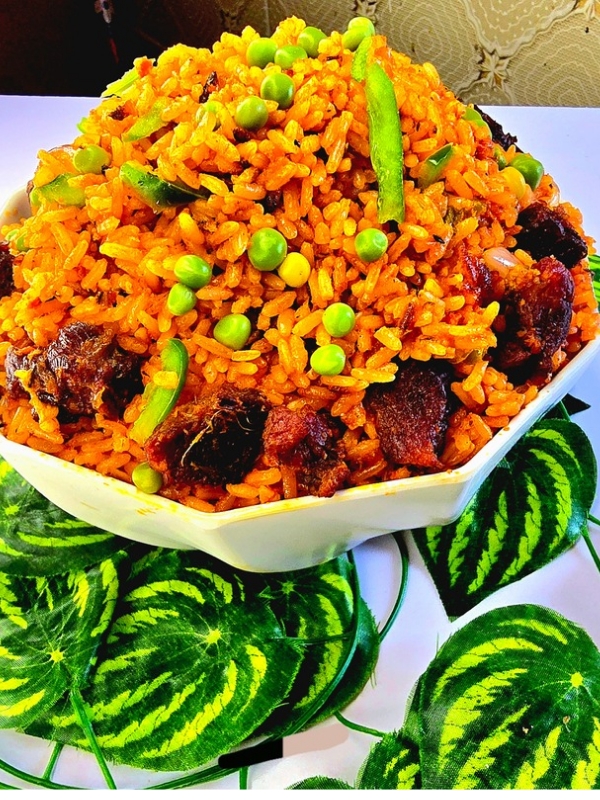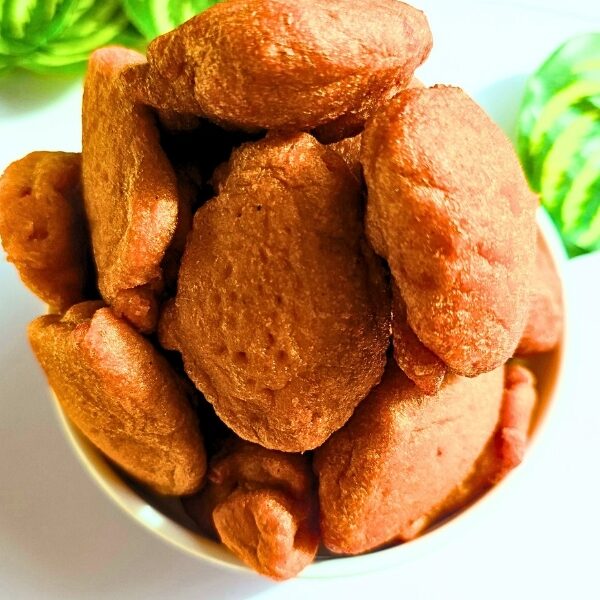How to Make Tastier Party Jollof Rice Using Nigerian Local Rice
This is How to Make Party Jollof Rice the best way ever.
There’s something unforgettable about the aroma of Nigerian party jollof rice. The smoky scent, the bright reddish-orange color, and the way every grain carries rich flavor — it all reminds many of us of celebrations back home.
For me, making jollof rice with local Nigerian rice brings back memories of family gatherings, laughter, and that unbeatable taste you just can’t get from imported rice.
In this post, I’ll walk you through how I made Nigerian Party Jollof Rice using local rice — a version that’s full of flavor, color, and nostalgia. Just like the kind you’d find at a true Nigerian celebration.
Ingredients on How to Make Party Jollof Rice
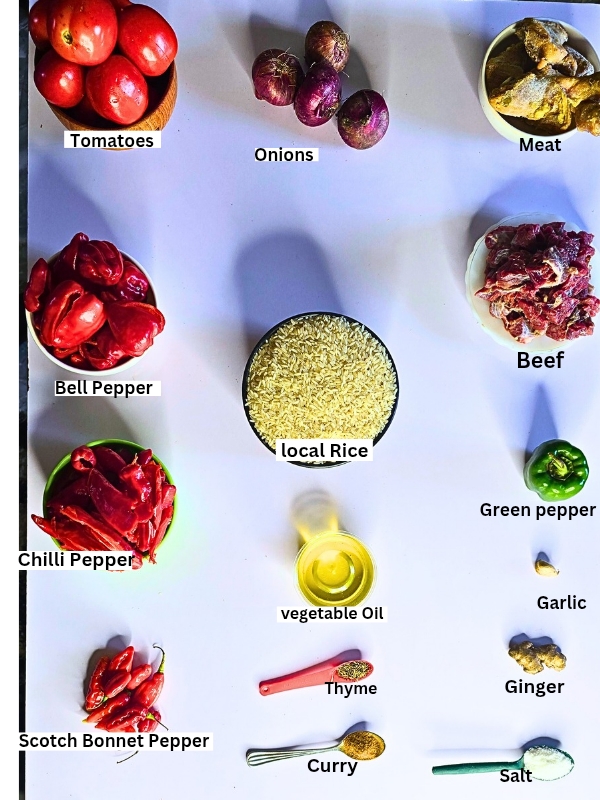
-
4 medium-sized onions
-
1 cup of groundnut oil
-
2 bay leaves
-
1 teaspoon of curry powder
-
1 teaspoon of thyme
-
1 teaspoon of salt (or to taste)
-
2 seasoning cubes
-
2 cloves of garlic
-
1 thumb-sized piece of ginger
-
1 medium-sized green bell pepper
-
9 small red peppers (atarodo)
-
1–2 medium-sized chili peppers
-
4 medium-sized bell peppers (tatashe)
-
2 cups of Nigerian local rice
-
A small portion of cowpeas (optional, for local flavor)
-
Some beef (steamed and fried)
-
2 tablespoons of butter
-
Chopped onions (for finishing touch)
A Taste of Home: Why Local Rice Matters
While many people prefer long-grain parboiled rice for their jollof, there’s something deeply authentic about using Nigerian local rice. Not only does it carry that earthy aroma, but it also absorbs flavor beautifully.
More importantly, it gives the dish that signature “party” texture — slightly smoky, yet soft inside. When I decided to make this dish, I wasn’t just cooking. Rather, I was reliving childhood memories: large family pots bubbling over outdoor fires, the smell of smoke blending with fresh pepper, and aunties debating who made the best jollof.
That nostalgic aroma is exactly what inspired me to recreate this dish using local rice.
Step-by-Step: How to Make Party Jollof Rice
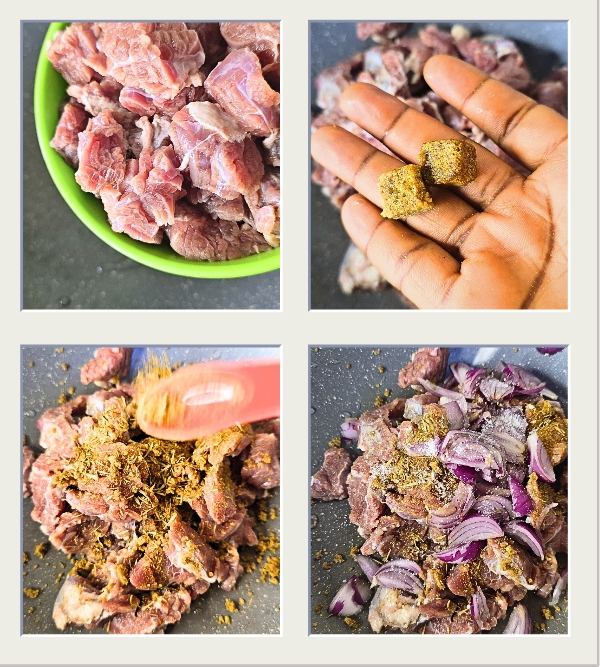
1. Prepare the Ingredients
First, wash and clean all your vegetables — the bell peppers, chili peppers, and red peppers. Peel the garlic and ginger, and slice the onions.
Set aside two onions for later frying and finishing.
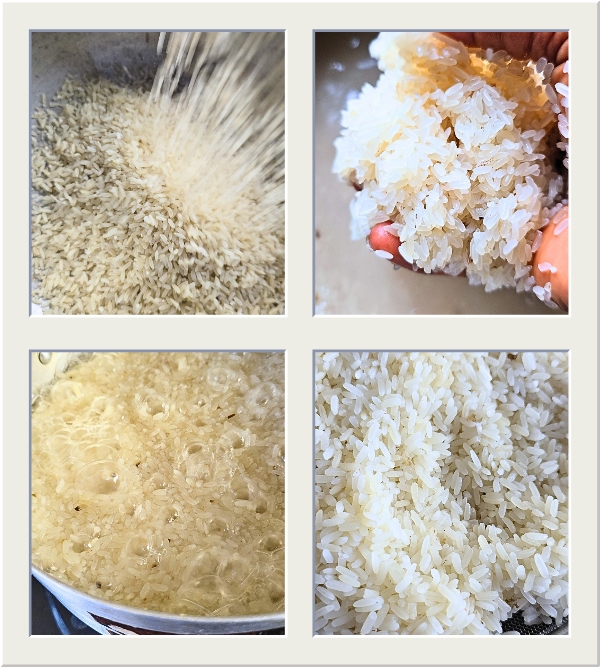
Meanwhile, wash your local rice thoroughly using warm water to remove excess starch and any dirt. Because local rice can contain husks or stones, take your time with this step. Proper cleaning ensures your jollof turns out neat and smooth.
2. Make the Pepper Blend
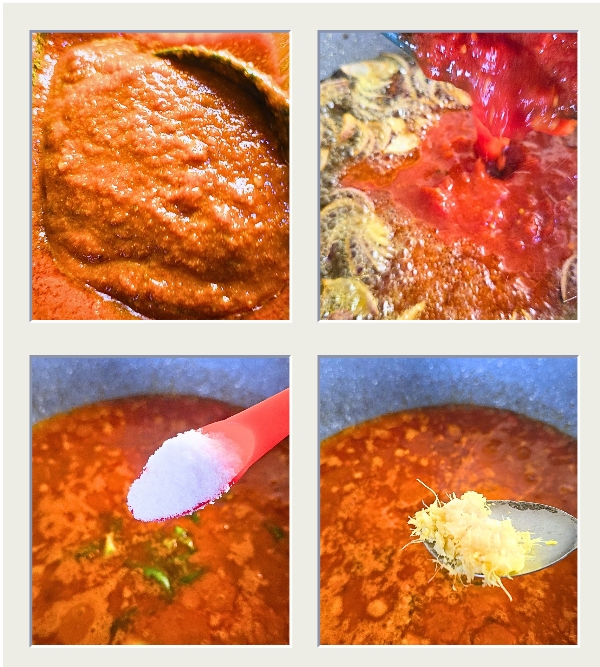
Next, blend the bell peppers, chili peppers, red peppers, garlic, ginger, and two of the onions into a smooth paste.
Once blended, pour the mix into a pot and cook on medium heat for about 15–20 minutes. Stir occasionally until the water evaporates and the mix becomes thick. This helps eliminate any raw taste and ensures it fries properly later.
3. Steam and Fry the Beef
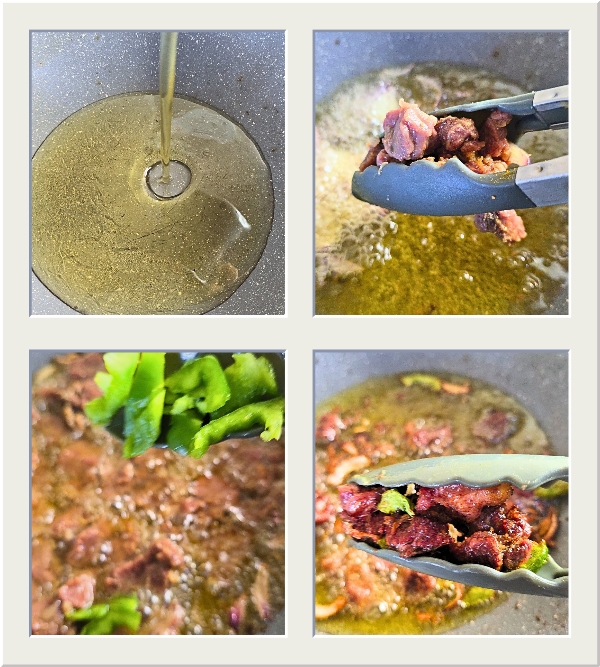
While the pepper is cooking, season your beef with salt, seasoning cubes, curry, and thyme. Then, add chopped onions and a little water. Steam on low heat until the meat becomes tender.
After that, fry the beef in hot oil until golden brown, and set aside. Importantly, do not discard the stock — it’s liquid gold that will enrich your jollof rice later.
4. Fry the Pepper Sauce
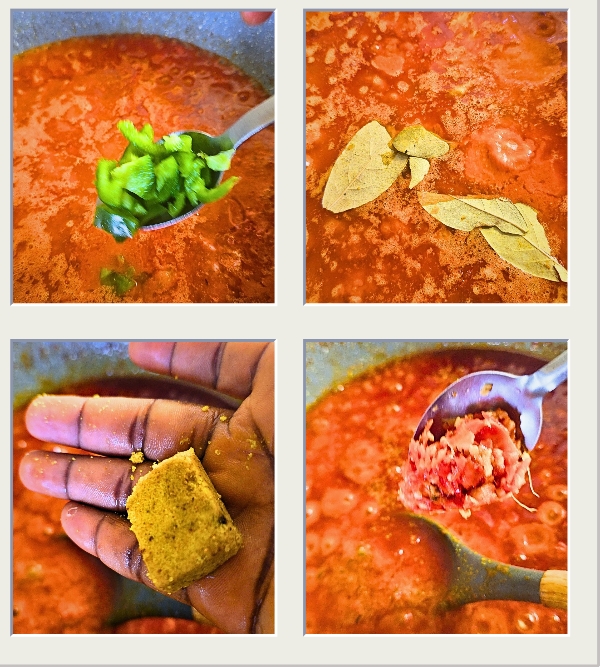
Now, in a large pot, heat the groundnut oil. Add your reserved chopped onions and sauté until translucent. The aroma should fill your kitchen beautifully.
Then, pour in the cooked pepper mix and stir well. Let it fry on medium heat for 10–15 minutes, stirring occasionally to avoid burning.
Afterward, add curry, thyme, and bay leaves. At this point, your kitchen will start to smell like a true Nigerian celebration.
Next, pour in your fried beef and the reserved beef stock. Add seasoning cubes and salt to taste, then stir to combine everything. Let it simmer for 5 more minutes to marry the flavors.
5. Add the Local Rice
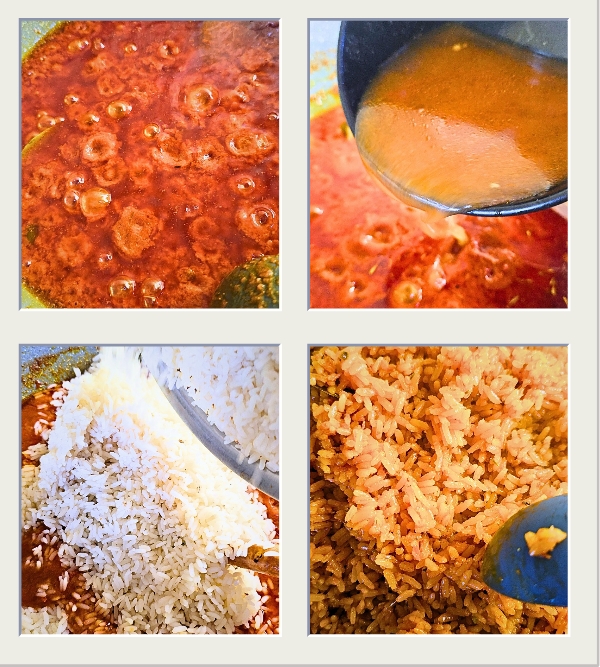
At this stage, pour your washed local rice directly into the sauce. Stir gently but thoroughly so every grain is well-coated.
Add water — just enough to cover the rice. Then, reduce the heat to low, cover the pot tightly, and allow it to cook slowly. This gentle cooking helps the rice absorb all the rich flavors without burning.
As it cooks, stir occasionally to prevent sticking and to check the texture.
6. Add Butter and Chopped Onions
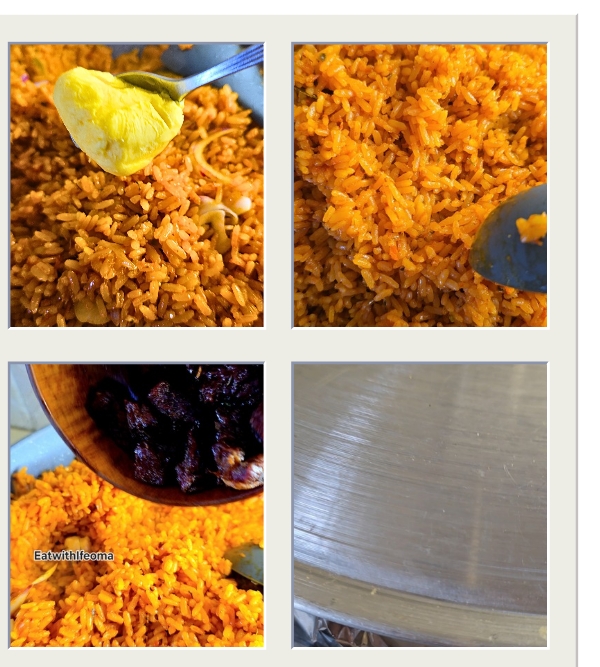
Once most of the water has dried up and the rice is almost cooked, it’s time to add the butter and reserved chopped onions.
Stir everything gently so the butter melts and coats the rice evenly. This step gives your jollof that shiny, party-style finish, while the onions add a fresh, final burst of flavor.
7. Steam with Foil for That Authentic Aroma
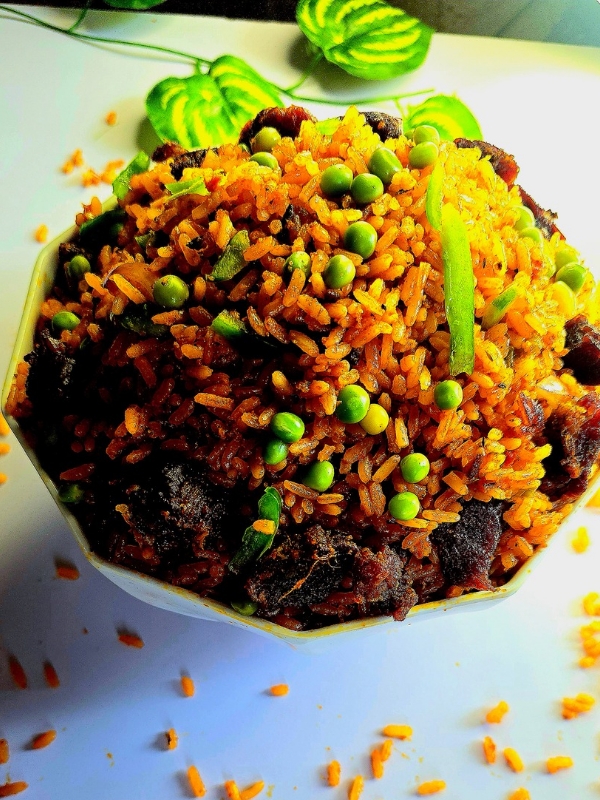
To finish, cover the pot with foil before placing the lid back on. This helps trap the steam, locking in that smoky, signature party aroma — even without firewood.
Let the rice steam for another 10 minutes on very low heat. When you remove the foil, you’ll be greeted by an aroma that instantly reminds you of weddings and festive gatherings.
Tips and Tricks on How to Make Party Jollof Rice Perfectly.
-
Use local rice wisely: It cooks faster than imported rice, so always use low heat and monitor your water levels closely.
-
Always fry the sauce properly: This step is crucial for developing a rich, deep flavor.
-
Don’t skip the foil: It’s the secret to mimicking that classic smoky flavor without using firewood.
-
Add butter at the right moment: Near the end of cooking, when most of the water has dried up.
-
Be patient: Great jollof isn’t rushed. Let every stage — from frying to steaming — happen slowly and richly.
Serving Suggestions
Nigerian Party Jollof Rice is best served hot and straight from the pot. You can enjoy it with fried beef, dodo (fried plantains), or creamy coleslaw.
Additionally, it pairs perfectly with grilled chicken, fish, or even moi moi for a fuller meal.
As for drinks, chilled zobo, fruit punch, or your favorite soft drink complements the spicy richness of this dish.
Conclusion: How to Make Party Jollof Rice
Cooking Nigerian Party Jollof Rice with local rice is more than just making food — it’s a cultural experience. Every spoonful tells a story of tradition, of celebration, and of home.
The local rice brings a rustic authenticity, while the butter and foil technique elevate it to something truly special.
So, the next time you’re craving that unforgettable party flavor, don’t wait for a celebration — create your own. This recipe brings the spirit of Nigerian parties right into your kitchen.
You May Also Like:
